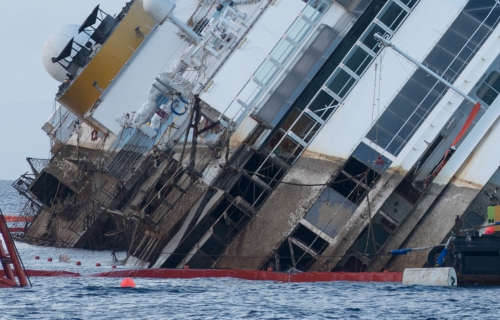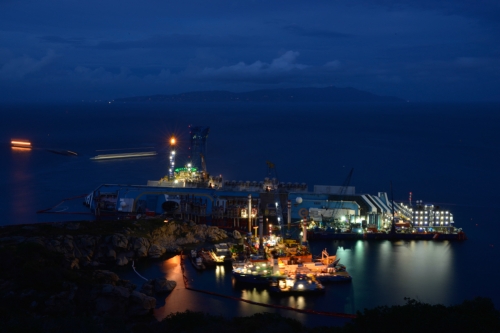Costa Concordia: Largest Refloat in History A Success [Photos]
The Costa Concordia was successfully pulled upright off the island of Giglio on Tuesday, in one of the world's most complex and expensive salvage operations which the prime minister said had boosted Italy's battered national pride.
In a 19-hour operation which ended at 4.00 a.m., the 114,500-ton ship was pulled from its side to an upright position by a series of huge jacks and cables and lowered onto underwater platforms drilled into the rocky sea bed.



Nick Sloane, the South African engineer who has led the operation for the U.S.-Italian contractors consortium Titan-Micoperi, was greeted by local residents as he came ashore. "I think the whole team is proud of what they achieved. A lot of people said it couldn't be done," he told reporters at the quayside before heading off to celebrate with jubilant colleagues. "I feel good, it's time for a beer."
When daylight broke, the marks of the giant liner's 20 months on the rocks were clearly visible. Brown mud and scum stains covered one half of the gashed and crumpled hull which had been crushed under its own weight.
The vessel, with two thirds of its body now resting in 30 metres of water, will remain in place for some months while it is stabilised and refloated before being towed away to be broken up for scrap.
After a three hour delay due to an overnight storm on Monday, the parbuckling operation, in which the hulk was painstakingly rotated upright, took much longer than the 10-12 hours estimated. Engineers said it had gone smoothly.



"It was a perfect operation, I would say," said Franco Porcellacchia, leader of Costa Cruise's technical team.
In a painstaking day of work on Monday, a series of massive jacks pulled the Concordia up inch by inch until it was raised high enough for water tanks welded to one side to start to pull it down into place by the force of gravity.
Six platforms, drilled into the rock and 16,000 tonnes of grouting piled up to create an artificial sea bed held the ship in place once it was upright.
Oil booms surround the vessel to intercept waste water and oil trapped in the ship, but officials said there appeared to have been no significant environmental damage.


The work will not be complete until the vessel is towed away from the island, probably by next spring but Sloane said any operational challenges could be met.
"The weather is the main thing, if you have good weather and you have a good plan, then you just have to follow the plan."
The Parbuckling Project kept us informed with constant updates:
Midnight: The ship has rotated approximately 25° with respect to the starting position. This means that the operation has gone beyond the point at which the vessel no longer needs to be pulled by the strand jacks and can now rotate under its own momentum and under the weight of the ballast water contained in the sponsons.
2.00 A.M: The vessel has rotated 35 degrees. Everything is going on according to plans.

that matters most
Get the latest maritime news delivered to your inbox daily.
4.00 A.M.: The parbuckling operation has been successfully completed. The wreck is now upright and resting safely on the specially built artificial sea bed, at a depth of approximately 30 meters.

